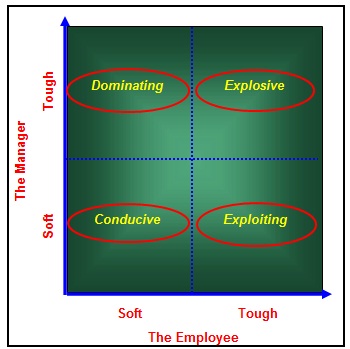Which Management Style is Best

The manager in my first job liked to breathe upon my neck to ensure that I was doing things right. He was the controlling kind and used to call me even if I was late by five minutes.
Oh and yes, he never used to spare the stick should he ever get the chance. He was fond of escalating and was fond of taking a stern tone in meeting rooms. But he was probably the most successful manager on the floor.
Studying management behavior
More often than not management behavior or management style is dependent on two factors
1. The Employee and
2. The Manager.
The Tough Guy
Tough Nut-cracker is that kind of manager who is very strict with all kinds of people. He is very aggressive and hopes to nurture his team to be aggressive.
This kind of Manager takes pride in all achievements of his team and more often than not dictates from the top. He likes to make decisions unilaterally and closely supervises his team members.
The Soft guy
This is that kind of manager who drives his team to take decisions on their own. He delegates most of the work and encourages the team to come up with their own solutions. His presence is only a guiding factor and he is always available there albeit as a helping hand. He does not believe in breathing upon the neck of his team.
Studying employee behavior
Like other things in life, management styles are also not in black or white but vary with shades of gray. But what is it that influences management behavior? It is the employee type. So, to understand what kind of management style is more effective it is also important to study employee behavior.
The tough employee
Like they say skills can be achieved but attitude cannot. This is typically the employee who is capable but lacks in positive attitude. These people need a tough hand and are smart enough to manipulate and arm twist the manager into not working or being less productive than what they are capable. They may also create a negative atmosphere and a negative energy in the team.
The Soft employee
This is the ideal guy who is a self motivated team player. He drives his own performance and is very participative. He does not indulge in back biting and tries to build a conducive environment around him. He usually does not question authority and tries to be participative in all arenas.
Understanding management style and work environment
Having understood the kind of employees, let us now see the combination of different kind of Managers and Employees. The below chart shows the environment under different combinations of employees and managers.

Dominating
An environment where the Manager dominates the employee and is pretty much in control. The manager dictates terms on most activities and closely supervises the team.
Explosive
This is that environment where both the employee and the manager are tough. So, the manager is like a task master to a lion in a circus ring. The employee refuses to back down and the manager breathes upon his neck to ensure that the tasks are achieved.
Conducive
Both the manager and the employee are soft. So, the manager seeks a participative environment and allows the employee free reign of things. The employee too respects these boundaries and gives in his best.
Exploiting
The manager is soft, whereas the employee is tough. The employee more often than does not realize it but the manager manages to extricate work from him and places credit on the employee’s shoulders. He gets motivated as he thinks he does all work and he gets credit for it.
It is interesting to note that irrespective of the management style and irrespective of the employee style, one can create a very productive environment. The one guiding light will be the employee morale and retention.
Conclusion
We have only talked about the outliers in this article here. But in reality, both the elements appear in varied proportions in varied individuals. Hence, the management style also needs to vary as per the situation and employee behavior.
So, pick your management style amiable and adapt as per the kind of situation. After all management is not just about getting work done, but also about developing people in the process.









Leave a Reply